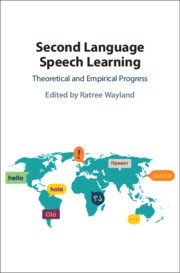Book contents
- Second Language Speech Learning
- Second Language Speech Learning
- Copyright page
- Dedication
- Contents
- Figures
- Tables
- Contributors
- Preface
- Acknowledgments
- Part I Theoretical Progress
- Part II Segmental Acquisition
- Chapter 6 English Obstruent Perception by Native Mandarin, Korean, and English Speakers
- Chapter 7 Changes in the First Year of Immersion
- Chapter 8 Effects of the Postvocalic Nasal on the Perception of American English Vowels by Native Speakers of American English and Japanese
- Part III Acquiring Suprasegmental Features
- Part IV Accentedness and Acoustic Features
- Part V Cognitive and Psychological Variables
- Index
- References
Chapter 8 - Effects of the Postvocalic Nasal on the Perception of American English Vowels by Native Speakers of American English and Japanese
from Part II - Segmental Acquisition
Published online by Cambridge University Press: 21 January 2021
- Second Language Speech Learning
- Second Language Speech Learning
- Copyright page
- Dedication
- Contents
- Figures
- Tables
- Contributors
- Preface
- Acknowledgments
- Part I Theoretical Progress
- Part II Segmental Acquisition
- Chapter 6 English Obstruent Perception by Native Mandarin, Korean, and English Speakers
- Chapter 7 Changes in the First Year of Immersion
- Chapter 8 Effects of the Postvocalic Nasal on the Perception of American English Vowels by Native Speakers of American English and Japanese
- Part III Acquiring Suprasegmental Features
- Part IV Accentedness and Acoustic Features
- Part V Cognitive and Psychological Variables
- Index
- References
Summary
Vowels are said to be less distinctive in prenasal context. The “pin/pen” merger in the Southern United States is a good example. This study attempts to investigate the effects of the postvocalic nasal on the identification and discrimination of American English vowels by native speakers of American English (NE) and Japanese (NJ). These two groups of participants identified six American English (AE) monophthongs /i, ɪ, ɛ, æ, ɑ, ʌ/ and discriminated six vowel pairs /i/-/ɪ/, /ɛ/-/ɪ/, /æ/-/ɛ/, /æ/-/ɑ/, /æ/-/ʌ /, and /ɑ/-/ʌ / in prenasal context. NJ also identified these American English vowels in terms of Japanese vowel categories. The results revealed that, overall, NE outperformed NJ in both identification and discrimination. In addition, how AE vowels were perceptually mapped to Japanese vowels predicted NJ’s discrimination. However, both groups’ performances were found to be poorer in the prenasal context when compared to their previous performances in the preplosive context (Nozawa & Wayland 2012), and NJ were more adversely (but differently) affected by nasalization than NE.
- Type
- Chapter
- Information
- Second Language Speech LearningTheoretical and Empirical Progress, pp. 228 - 246Publisher: Cambridge University PressPrint publication year: 2021

